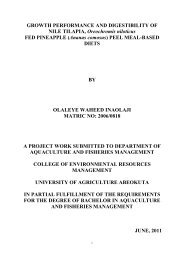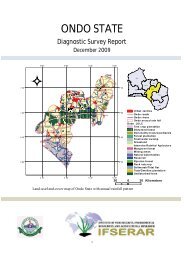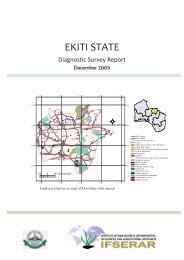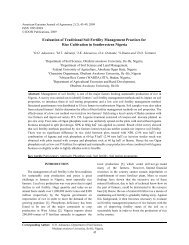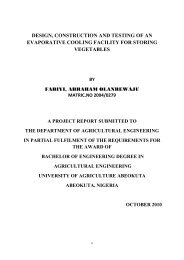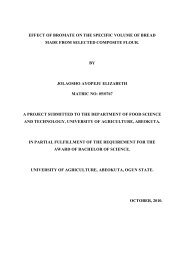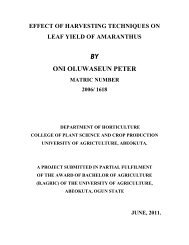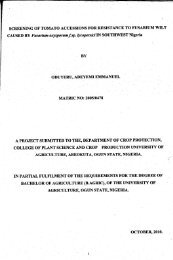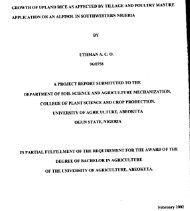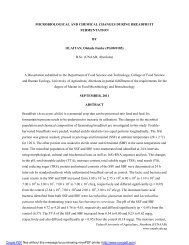presence of aflatoxins in smoked-dried fish sold in abeokuta, ogun ...
presence of aflatoxins in smoked-dried fish sold in abeokuta, ogun ...
presence of aflatoxins in smoked-dried fish sold in abeokuta, ogun ...
Create successful ePaper yourself
Turn your PDF publications into a flip-book with our unique Google optimized e-Paper software.
CHAPTER FIVE<br />
5.0 DISCUSSION, CONCLUSION AND RECOMMENDATIONS<br />
5.1 DISCUSSION<br />
Results obta<strong>in</strong>ed from this study showed that <strong>aflatox<strong>in</strong>s</strong> were found to be associated with<br />
<strong>smoked</strong>-<strong>dried</strong> <strong>fish</strong>es <strong>sold</strong> <strong>in</strong> different markets <strong>in</strong> Abeokuta, but <strong>in</strong> non-significant levels<br />
(0.030ppb-1.150ppb) that may not be toxic to human health accord<strong>in</strong>g to the regulatory levels for<br />
<strong>aflatox<strong>in</strong>s</strong> issued by the Food and Adm<strong>in</strong>istration (FDA) <strong>of</strong> the United States (The FDA<br />
regulatory levels for aflatox<strong>in</strong> <strong>in</strong>take for humans and all animal species is maximum <strong>of</strong> 20 ppb).<br />
Adebayo-Tayo et al. (2006), reported different results <strong>in</strong> marketed <strong>smoked</strong>-<strong>dried</strong> <strong>fish</strong> stored for<br />
sale <strong>in</strong> Uyo, Akwa-Ibom State, whereby the <strong>presence</strong> <strong>of</strong> <strong>aflatox<strong>in</strong>s</strong> were <strong>in</strong> higher concentrations<br />
(The Aflatox<strong>in</strong> concentrations <strong>in</strong> the samples were between 1.5ppb – 8.1ppb) <strong>in</strong> the samples<br />
which might probably make their consumption hazardous to health. Such a higher difference <strong>in</strong><br />
aflatox<strong>in</strong> concentrations might be as a result <strong>of</strong> higher relative humidity usually recorded <strong>in</strong> Uyo,<br />
unlike Abeokuta town. This might favour the accumulation <strong>of</strong> aflatox<strong>in</strong> due to high moisture<br />
content when displayed for sale <strong>in</strong> the market. The processes <strong>of</strong> handl<strong>in</strong>g <strong>fish</strong>es are also prone to<br />
aflatox<strong>in</strong> contam<strong>in</strong>ation especially <strong>in</strong> artisanal <strong>fish</strong>ery due to unhygienic methods <strong>of</strong><br />
preservation. Accord<strong>in</strong>g to Akande and Tobor (1992), <strong>in</strong> artisanal <strong>fish</strong>ery, freshly caught <strong>fish</strong> are<br />
covered with damp sacks and at times, they are mixed with wet grass or water weeds to reduce<br />
the temperature. Fish treated this way is prone to contam<strong>in</strong>ation with microorganisms such as<br />
bacteria and fungi. This <strong>in</strong>dicates that spoilage <strong>of</strong> <strong>fish</strong> starts shortly after harvest<strong>in</strong>g. Dur<strong>in</strong>g the<br />
smoke-dry<strong>in</strong>g period, smok<strong>in</strong>g kilns used <strong>in</strong> artisanal <strong>fish</strong>ery and the overload<strong>in</strong>g <strong>of</strong> the <strong>fish</strong>es on<br />
the trays leads to improper process<strong>in</strong>g which <strong>in</strong> turn encourages aflatox<strong>in</strong> contam<strong>in</strong>ation (Eyo,<br />
1992). Dur<strong>in</strong>g storage <strong>of</strong> <strong>smoked</strong>-<strong>dried</strong> <strong>fish</strong> products, good storage practices are not adhered to,<br />
hence stores are not well ventilated and pests can easily ga<strong>in</strong> access <strong>in</strong>to the stores. The<br />
environment <strong>in</strong> which <strong>fish</strong>es are displayed <strong>in</strong> the market is not always hygienic and this is<br />
another avenue for aflatox<strong>in</strong> contam<strong>in</strong>ation. Very <strong>of</strong>ten, retailers display the <strong>smoked</strong>-<strong>dried</strong> <strong>fish</strong>es<br />
<strong>in</strong> open trays beside the gutter on refuse heaps, this also encourages fungal attack and subsequent<br />
production <strong>of</strong> tox<strong>in</strong>s. This is <strong>in</strong> agreement with the report <strong>of</strong> Akande and Tobor (1992). The<br />
37



